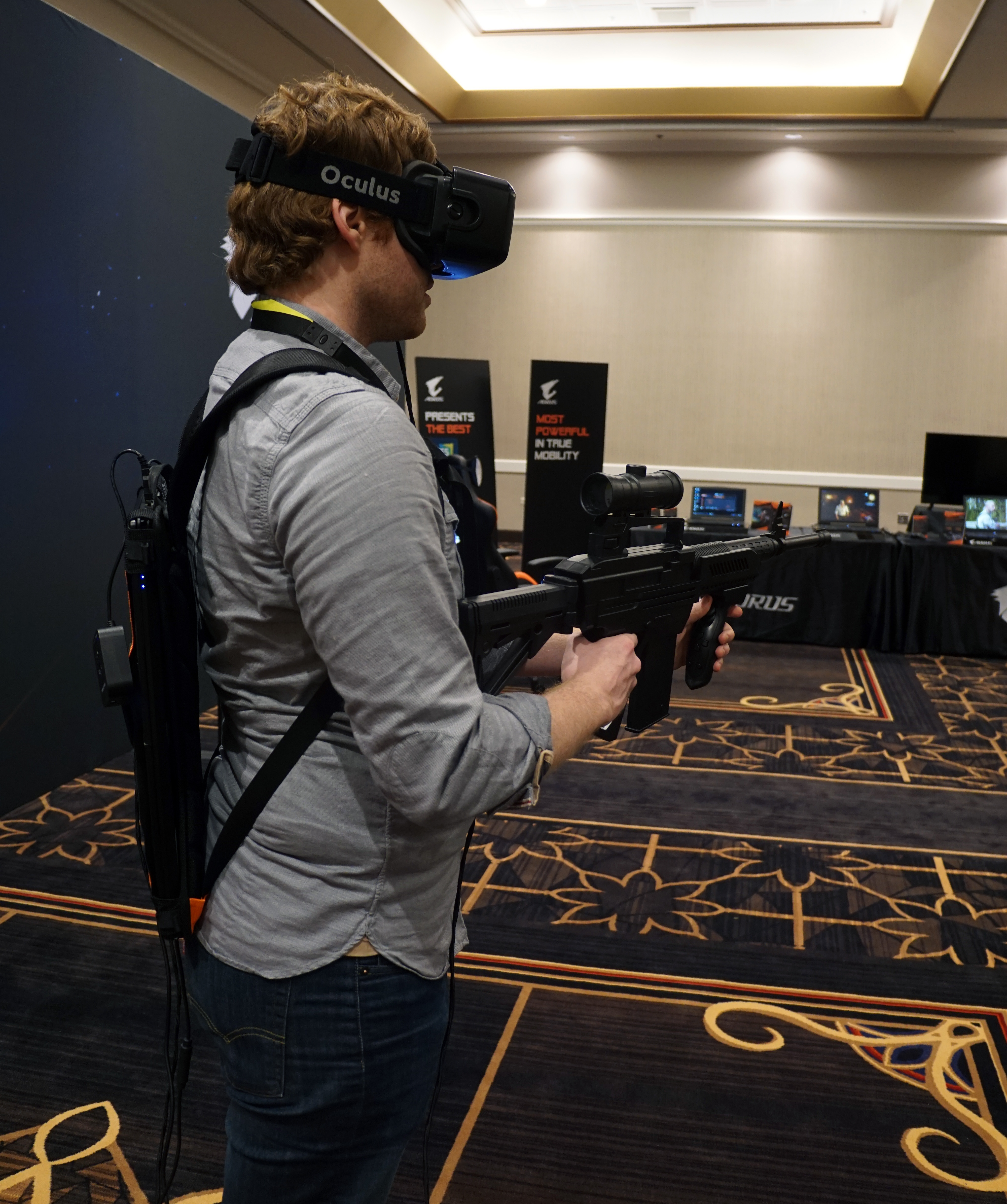Strapping a laptop to your back doesn't solve VR's cable problem (yet)

Over the past year and a half, I’ve done at least a dozen standing VR demos. I’ve put on the Oculus Rift or the HTC Vive and walked around a small room, taking delicate, careful steps to move around in virtual worlds. I haven’t tripped over a cable and embarrassed myself by falling down, or destroyed a headset by stepping on the cable and yanking it out of its mounting. Yet. It feels like an inevitability. When I have a VR headset in my own home, and I’m used to wearing it, I’ll relax. I’ll stop being careful. And I’m pretty sure I’ll break something. Hopefully not a $600 headset or a $1500 PC.
The cable is still a big unsolved problem for VR. Especially for the HTC Vive, which first and foremost distinguishes itself from the Oculus Rift with room scale VR. I don’t know what the popular solution to this problem will be, but I did experience one amusing potential solution at Gigabyte’s showcase at CES last week: a laptop harness. Basically, I strapped a high-powered laptop to my back, put on an Oculus Rift DK2, and used a ridiculous plastic gun controller to play Star Wars Battlefront in VR. This felt very silly.
Gigabyte designed a harness to fit its Aorus X7 DT gaming laptop, which had enough processing muscle to run Battlefront in VR. That’s largely thanks to its desktop-caliber GTX 980, which Nvidia introduced for laptops last fall. Despite being a beefy gaming laptop, the X7 DT felt surprisingly light on my back; it helped that the harness was stripped down to the bare essentials: a padded backing and a few straps to hold everything together. This made the rig smaller and lighter than the usual backpack you’d wear for such a large system.

It was actually pretty cool to have an entire VR system on my back, and I can see the appeal of a fully portable high-end VR rig. I have friends who have taken the cable-free smartphone-based GearVR to family gatherings and had a blast with them. That’s just not going to work with a desktop, but it could work with a laptop. Battlefront wasn’t made for VR and the setup I tried used some third-party software to awkwardly map mouse controls to VR look (and a directional pad on the gun controller made moving doubly awkward), but paired with SteamVR, the system could be pretty cool.
There’s just one little bitty problem: the laptop still needed a power cable. That desktop-caliber 980 is seriously power hungry, and without power the system would definitely throttle down and wreck the framerate. And when you lose frames in VR, the next thing you lose is your lunch.
Okay, so Gigabyte’s laptop rig mostly felt like one of those amusing, never-actually-going-to-happen accessories that pops up around a hot new technology. That’s what CES is all about: someone has a “what if” idea that most of us would have a good laugh about, only they turn it into a real product, instead.
Maybe, though, the Aorus X7 DT will be powerful enough untethered from the wall to run the least demanding VR games. And if it’s not quite that powerful now, the march of laptop technology may make it viable in a year or two. That’s entirely likely. The other solution is a very powerful (and expensive) battery, which has already proven successful in some custom made Oculus Rift rigs. That’s not practical enough to be an affordable solution, but it’s still progress.
Keep up to date with the most important stories and the best deals, as picked by the PC Gamer team.
For now, Gigabyte hasn’t solved the VR cable problem. But at least it got me a pretty funny picture.

Wes has been covering games and hardware for more than 10 years, first at tech sites like The Wirecutter and Tested before joining the PC Gamer team in 2014. Wes plays a little bit of everything, but he'll always jump at the chance to cover emulation and Japanese games.
When he's not obsessively optimizing and re-optimizing a tangle of conveyor belts in Satisfactory (it's really becoming a problem), he's probably playing a 20-year-old Final Fantasy or some opaque ASCII roguelike. With a focus on writing and editing features, he seeks out personal stories and in-depth histories from the corners of PC gaming and its niche communities. 50% pizza by volume (deep dish, to be specific).

